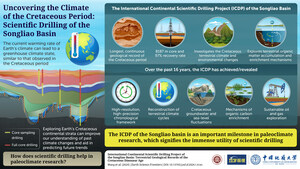New Study in "Earth Science Frontiers" Explores an Untapped Reserve of Oil and Gas Resources
BEIJING, Sept. 9, 2022 /PRNewswire/ -- Modern societies are still very much dependent on oil and gas resources for their smooth functioning. However, natural oil and gas resources are limited and non-renewable. In order to keep up with the growing demand for hydrocarbons, we need to find and secure alternate sources of natural oil and gas. Fortunately, a massive and mostly untapped reserve of oil and gas waits beneath us.
Oil shale is a flaky sedimentary rock with high organic content. When low-maturity oil shale is heated for extended periods of time, its organic molecules break down via pyrolysis and transform into lighter and more useful oil and gas. This forms the basis of a promising strategy known as in situ upgrading (ISU), whereby heating wells are drilled and laid out directly into the shale layer to provide the necessary heat for pyrolysis. The hydrocarbons produced on site are then extracted through a separate production well. While the process is technically feasible, there is, however, no agreement on whether it is economically feasible as well.
To address this knowledge gap, a research team from Northeast Petroleum University, China and China University of Petroleum in East China recently conducted a study on ISU technology. Led by Dr. Li Wenbiao from Northeast Petroleum University, the team analyzed the economic feasibility of ISU from the perspective of the energy consumption ratio (ECR). Put simply, ECR is a measure of how much of the energy provided to the heating wells is used for pyrolysis in relation to the energy lost to heat diffusion and absorption into minerals, water, and surrounding rock.
As described in their paper published in Earth Science Frontiers, the team employed a geological model to look into the factors that affect ECR the most. In their model, they accounted for the heating well design and layout, heating technology, and shale composition, among other parameters and variables. A video summary of this study is now available on YouTube. Also visit the press release website: https://www.earthsciencefrontiers.net.cn/EN/news/news31.shtml
The results of their analysis indicate that appropriate spacing between the heating and production wells is crucial to improve the efficiency of ISU. The team also determined the minimum total organic content in the oil shale that leads to acceptable ECR values. Moreover, they also compared and contrasted new heating methods to increase the efficiency of ISU beyond the conventional approach using heating wires. "One important way to increase the efficiency of ISU is to explore alternative heating technologies, such as convection and electromagnetic heating," highlights Dr. Wenbiao.
Overall, the team hopes that the findings of their study would help pave the way for an economically viable ISU technology. "We want our results to promote the application of ISU technology for optimized oil shale exploitation," says Dr. Wenbiao.
Let us hope his vision becomes a reality soon and that low-maturity oil shale becomes a reliable source of hydrocarbons to meet our energy demands.
Reference
DOI: https://doi.org/10.13745/j.esf.sf.2022.8.33-en
Title of original paper: Economic feasibility and efficiency enhancement approaches for in situ upgrading of low-maturity organic-rich shale from an energy consumption ratio perspective
Journal: Earth Science Frontiers
Xiaolong Wang
[email protected]
+86 13522262702
SOURCE Earth Science Frontiers

WANT YOUR COMPANY'S NEWS FEATURED ON PRNEWSWIRE.COM?
Newsrooms &
Influencers
Digital Media
Outlets
Journalists
Opted In





Share this article